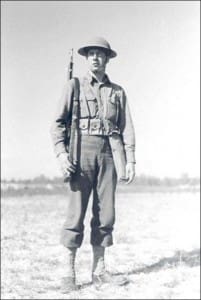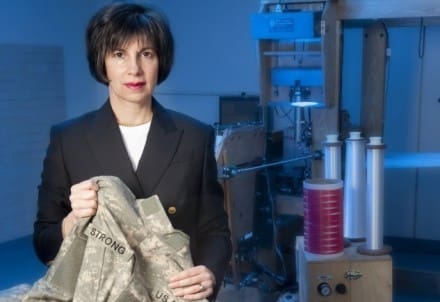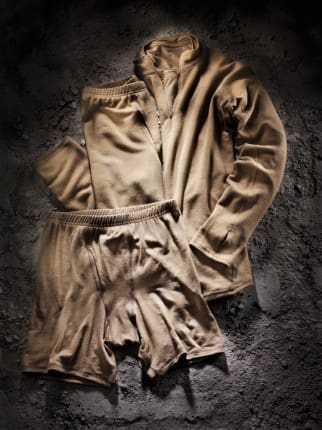 While this isn’t exactly breaking news, the fact that the Army is publicly acknowledging their efforts regarding wool is. Wool was long a mainstay of Soldier clothing. Take for example this Soldier circa 1941. He is essentially wearing the same clothing that his forebears wore in the trenches of World War I. This same gear served us well through World War II, Korea and on. Wool pieces remained in the cold weather bag up into the 90s. And then, beginning in the 60s with selected items up through early 90s, the services began to turn away from wool in favor of synthetics such as polypropylene and acrylic. As operations in Afghanistan and Iraq ramped up, the flame threat associated with Improvised Explosive Devices caused a shift to a new generation of FR performance fabrics.
While this isn’t exactly breaking news, the fact that the Army is publicly acknowledging their efforts regarding wool is. Wool was long a mainstay of Soldier clothing. Take for example this Soldier circa 1941. He is essentially wearing the same clothing that his forebears wore in the trenches of World War I. This same gear served us well through World War II, Korea and on. Wool pieces remained in the cold weather bag up into the 90s. And then, beginning in the 60s with selected items up through early 90s, the services began to turn away from wool in favor of synthetics such as polypropylene and acrylic. As operations in Afghanistan and Iraq ramped up, the flame threat associated with Improvised Explosive Devices caused a shift to a new generation of FR performance fabrics.
In recent years there has been a move to investigate the possibility of reintroducing nature’s performance fabric into the Soldier’s kit bag. Wool’s advantages, particularly of the Merino variety, are myriad.
-Warm even when wet
-Comfortable in a wide range of temperatures as well as against the skin
-Antimicrobial
-Inherently FR (No Melt, No Drip)
-Grown Naturally
Now, according to an Army press release, Natick Soldier Research, Development, and Engineering Center has contracted for several efforts with the American Sheep Industry Association and its subsidiary, Sheep Venture Company, to develop, test and evaluate wool fabrics for combat clothing. The ASI is no slouch, with over 45 state sheep associations, all told it represents more than 82,000 sheep producers.
“We can enhance wool’s inherent properties by engineering high-performance fiber blends and fabric structures. It all begins with the wool fiber fineness, where some breeds of sheep and what they are fed directly affect the wool fiber diameter and flexibility,” said Carole Winterhalter, textile technologist for NSRDEC.
“In the military world, Natick is recognized as working on cutting-edge technologies in support of all Soldiers, Sailors, Airmen and Marines. Work done at Natick is thorough and credible,” said Mitchell Driggers, program manager for Sheep Venture Company, or SVC, and government contracting consultant of the American Sheep Industry, known as ASI.
“Natick provides the expertise of textile technologists to engineer optimized individual clothing for the field,” Winterhalter said.
In 2009 NSRDEC selected three organizations for Phase I Small Business Innovation Research contracts specifically calling for shrink-resistant treatments for wool and our friends at Propel LLC were involved in these efforts. SVC received the Phase II contract and created different wool shrink-resist techniques through chemical and enzyme-based technologies. Subsequently, the sheep and wool industry spent its own funds to install a manufacturing line with energy-efficient equipment to run the shrink treatments.
This line accommodates multiple shrink treatment methods. SVC’s washable wool line exceeded its production by more than 40 percent in the first year, and the company expects to double its production this year.
“The work done with Natick Labs is important because ASI is able to better understand the needs of all of the military services,” said Rita Samuelson, wool marketing director for ASI. “Together, we can develop products that are functional and valuable to our servicemen and women.”
There has been an impression that there isn’t enough domestic wool to go around, but the facts belie the myth. The US wool industry exports approximately 65 percent of American-grown raw and semi-processed wool to overseas markets, and 10-15 percent is used by the domestic textile industry. The rest is consumed by the US military.
The next step is engineering better performing wool blends. For example, spinning long-staple (four-inch) wool into worsted yarns with Nomex and Kevlar fibers from DuPont was done through NSRDEC and SVC for flame resistance and durability purposes.
“We believe we’ll be able to make a fabric that is much stronger with the long-staple worsted yarns,” Winterhalter said. “We’ve already demonstrated a 20 percent increase in yarn strength over the previous short-staple yarns.”
On the other hand, New Balance is out in front of this concept as well with their FR wool blend featuring FR Rayon.
“Through these different parameters, we can engineer high-tech protective clothing made from environmentally friendly natural means,” Winterhalter said. “We hope these fabrics will be used across the board for FR applications, just as the nylon/cotton blend has been the all-purpose combat uniform fabric.”
To further refine the technology, SVC was awarded a three-year contract to develop FR fabrics for the future.
“Wool does not melt or drip and has significant fire-resistant qualities, both of which can help protect Soldiers from IEDs,” Samuelson said.
The advantages of wool for the Soldier are obvious. It is truly nature’s performance fabric and when combined with other technologies, performance is further enhanced. For the Army and by extension the taxpayer, wool offers a cost advantage. Expect to see more and more companies enter the domestic wool game as they eye military business.
Tags: American Sheep Industry Association, Natick, New Balance, Propel, Sheep Venture Company




This sounds awesome…I dropped point6 a line about getting team soldier certified hopefully they pursue that. I’d love to be able to get some Merino Wool shirts…will New Balance be opening up their Merino products for sale?
Ibex makes 70% of their goods here in the USA. Next fall they will start having goods made from USA raised sheep in MT rather than NZ & AUS like everyone else.
Their 17.5 t-shirts are awesome, the Nomad hoody is a favorite…feels like fleece.
Yeah…and I would say that’s not relatively affordable as I don’t buy $50 t-shirts.
Aaron – do a little research. $50 for a Merino t-shirt is pretty much the going rate. The nice thing about Ibex is that they make most of their stuff in the good ol’ USA. Just about all the other high-end Merino clothing companies make their products in China.
I would expect to see Ibex’s prices come down a little with the implementation of the US sources wool.
If wool costs 5X what nomex,rayon,or cotton does, this is all a pipe dream. The DOD has budget cuts, remember?
FINALLY!
As an “old guy” when I went on patrols and convoys in Iraq some years ago, in the winter months, I wore my old GI wool shirt, from the pre-ECWCS days, over the wool/cotton long john top. I have had these for years (since pre-ECWCS) and with proper care, they are quite durable.
The wool shirt fit perfectly under my MCCUU blouse- you couldn’t even see it.
Great news. My ideal shell fabric (in theory at least) is a 100 denier wool whipcord with 10% elastic content and a good DWR treatment. A man can always dream…
If I only had to wear a single type of fabric for the rest of my life, it would be wool. I use wool all year around, from lightweight (130gr/m2) t-shirts during the summer, too heavy 600gr/m2 shirts when it’s cold as fuck.
I’m wearing Merino year-round here in Germany. Definitely a convert to the new, softer Merino. Noting like the old, itchy and scratchy wool the Army gave me in the 1980’s!
I’m a wool lover too. I buy my own smart wool socks for daily wear in and out of uniform all year long and have bought a few Filson long sleeve “sleeper shirts” for use in cold weather. Love the Merino Wool
Hi Soldier Systems Readers,
Our Berry Amendment Compliant Merino wool collection was recently added to our web site:
http://www.shopnewbalance.com/search_results.asp?searchType=quick&qry=merino+
I would be happy to answer any questions you may have about any of the items.
Thank you,
Roland
Will you sell to Canadians?
Hi Paul,
I just spoke to customer service, from our shopNB web site we can only ship to Canadian Military installations not residential addresses.
Our wool is also available on GSA Advantage if you can take advantage of that.
I hope this works for you.
Thank you,
Roland
FINALLLY!!!!
Do you see your prices lowering anytime soon? I’m wanting more than a few and right now I’m on a slimmer budget than I have been.
Hi Aaron,
We don’t see the pricing coming down. This is a very complex US manufactured fabric that has X-Static®, Nylon and Rayon yarns in the blend. The garments are also manufactured at at US factory. For me the main benifit is that you get the wide ranging comfort of wool combined with the wicking and drying of synthetic performance base layer.
Thank you,
Roland
Good luck soldier-proofing wool. My girlfriend goes full-on retard with merino in the laundry room and she’s the type that thinks the world needs good towels to put out for houseguests.
It’s funny that I read this now, as I have been slowly switching all of my hunting/outdoor kit back to wool for a year or so. It has been 10x better than most all of my high-tech synthetics. In fact, go up to AK, and most of the old timers that spend any serious time in the bush still sport the boiled wool pants, coats, etc. Don’t get me wrong, a Gore-Tex shell still has it’s place, but as an insulating layer, wool just can’t be beat.
At deer camp this year we were all joking around: Do you know why your grandparents and their parents wore the stuff for hundreds of years? Because it works.
Wool is awesome. It works, keeps you dry & warm, is FR and makes your mates smell less like balls. Wanna’ wash it? Soap, water, wring, dries more or less instantly.
It’s almost as if nature is better at creating materials than some dude in a lab is.
Hey guys. I did a post recently about point6 merino socks, so if you want more detailed information about the benefits of merino wool, you should check it out: http://afmointel.com/featured/point6-merino-socks/.
I’m wearing a pair right now
I own 16 pairs…looking to get more.
Be careful with the research. Wool also has drawbacks. I spent weeks under bivi shelter on the old east German border, in the the 50’s. The old battledress turned to an abrasive ‘crutch shredder’ when wet and was hard to dry out. Look at the flame proofing they use in the Firebrigade.
The 1950s? Wow! I bet you have stories
I thought Merino wool only came from New Zealand
Nah, Merinos have been being raised in the States for going on two centuries now. http://vermonthistory.org/index.php?option=com_content&task=view&id=298&Itemid=176
I have been wearing Columbia’s camo wool hunting pants and jacket during late muzzleloader season here in Iowa for going on 10 years now. I beat the heck out of the stuff and it does the trick wet or dry in temps from below zero on up if I layer it correctly. Not sure how Columbia’s stuff compares with everybody else’s, but their wool goods have worked well for me.
wool IS NOT ANTIMICROBIAL!!! really people, bacterial growth is rampid in AATCC 100 test, not that I want to get all technical but lets not mis-inform. It isnt inherently FLAME RESISTANT either, vertical flame test takes care of that one….great material but it needs a lot of help…..